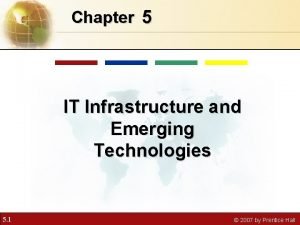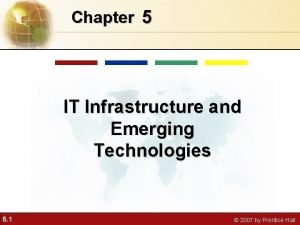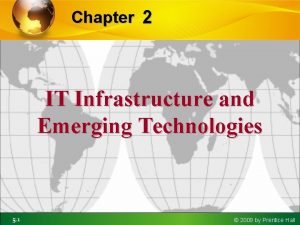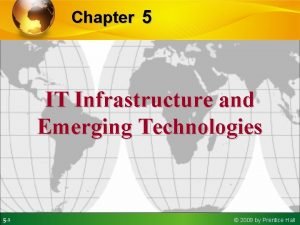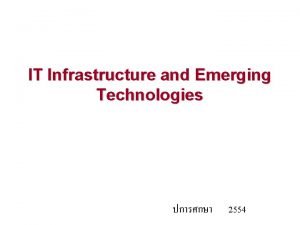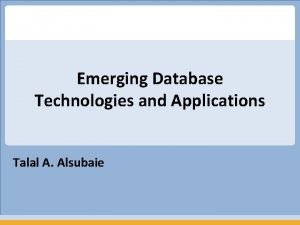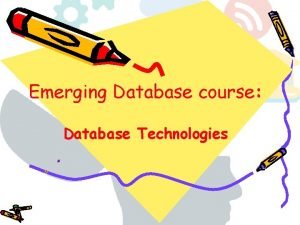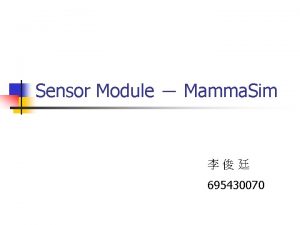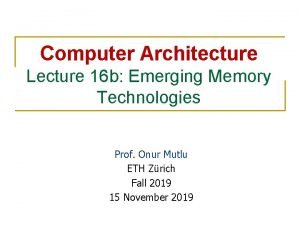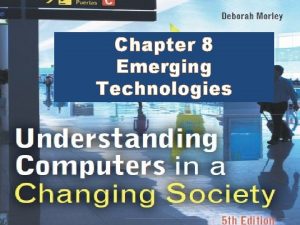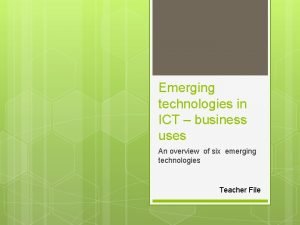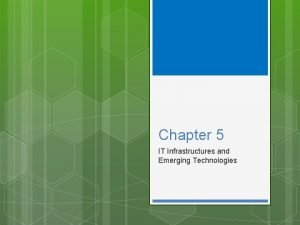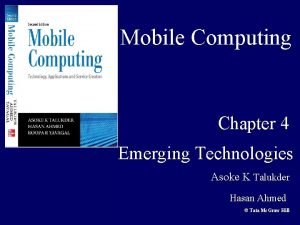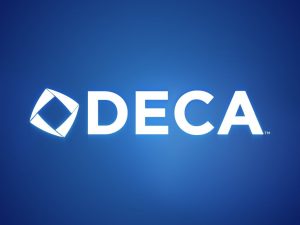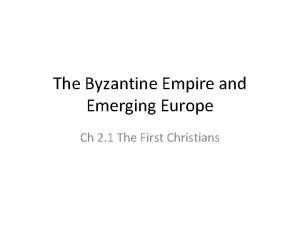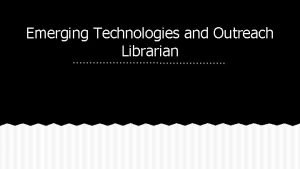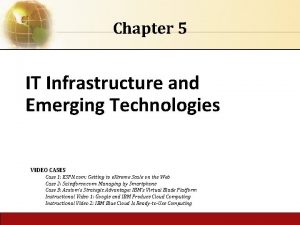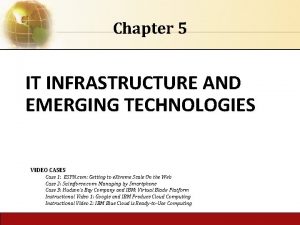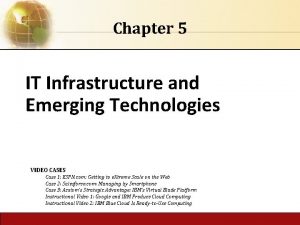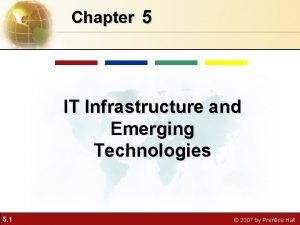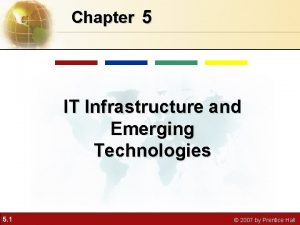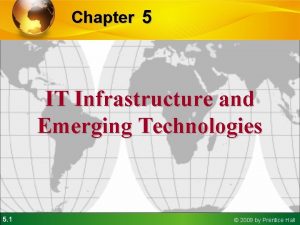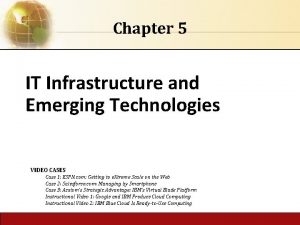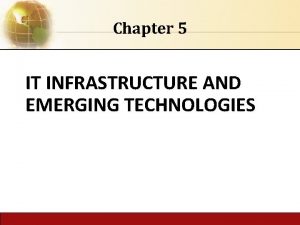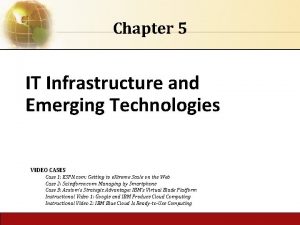Chapter 2 IT Infrastructure and Emerging Technologies 5
















- Slides: 16

Chapter 2 IT Infrastructure and Emerging Technologies 5. 1 © 2009 by Prentice Hall

Management Information Systems Chapter 5 IT Infrastructure and Emerging Technologies IT Infrastructure • Defining IT infrastructure: • Set of physical devices and software required to operate enterprise • Set of firmwide services including: • • • Computing platforms providing computing services Telecommunications services Data management services Application software services Physical facilities management services IT management, standards, education, research and development services • “Service platform” perspective more accurate view of value of investments 5. 2 © 2009 by Prentice Hall

Management Information Systems Chapter 5 IT Infrastructure and Emerging Technologies IT Infrastructure Connection Between the Firm, IT Infrastructure, and Business Capabilities The services a firm is capable of providing to its customers, suppliers, and employees are a direct function of its IT infrastructure. Ideally, this infrastructure should support the firm’s business and information systems strategy. New information technologies have a powerful impact on business and IT strategies, as well as the services that can be provided to customers. Figure 5 -1 5. 3 © 2009 by Prentice Hall

Management Information Systems Chapter 5 IT Infrastructure and Emerging Technologies IT Infrastructure • Evolution of IT infrastructure • General-purpose mainframe and minicomputer era: 1959 to present • 1958 IBM first mainframes introduced, eventually used to support thousands of online remote terminals • 1965 less expensive DEC minicomputers introduced, allowing decentralized computing • Personal computer era: 1981 to present • 1981 Introduction of IBM PC • Proliferation in 80 s, 90 s resulted in growth of personal software • Client/server era: 1983 to present • Desktop clients networked to servers, with processing work split between clients and servers • Network may be two-tiered or multitiered (N-tiered) • Various types of servers (network, application, Web) 5. 4 © 2009 by Prentice Hall

Management Information Systems Chapter 5 IT Infrastructure and Emerging Technologies IT Infrastructure Eras in IT Infrastructure Evolution Illustrated here are the typical computing configurations characterizing each of the five eras of IT infrastructure evolution. Figure 5 -2 A 5. 5 © 2009 by Prentice Hall

Management Information Systems Chapter 5 IT Infrastructure and Emerging Technologies IT Infrastructure • Evolution of IT infrastructure (cont. ) • Enterprise Internet computing era: 1992 to present • Move toward integrating disparate networks, applications using Internet standards and enterprise applications • Cloud Computing: 2000 to present • Refers to a model of computing where firms and individuals obtain computing power and software applications over the Internet • Fastest growing form of computing 5. 6 © 2009 by Prentice Hall

Management Information Systems Chapter 5 IT Infrastructure and Emerging Technologies IT Infrastructure A Multitiered Client/Server Network (N-Tier) In a multitiered client/server network, client requests for service are handled by different levels of servers. Figure 5 -3 5. 7 © 2009 by Prentice Hall

Management Information Systems Chapter 5 IT Infrastructure and Emerging Technologies IT Infrastructure • Technology drivers of infrastructure evolution (cont. ) • Standards and network effects • Technology standards: • Specifications that establish the compatibility of products and the ability to communicate in a network • Unleash powerful economies of scale and result in price declines as manufacturers focus on the products built to a single standard 5. 8 © 2009 by Prentice Hall

Management Information Systems Chapter 5 IT Infrastructure and Emerging Technologies Infrastructure Components • IT Infrastructure has 7 main components • • 5. 9 Computer hardware platforms Operating system platforms Enterprise software applications Data management and storage Networking/telecommunications platforms Internet platforms Consulting system integration services © 2009 by Prentice Hall

Management Information Systems Chapter 5 IT Infrastructure and Emerging Technologies Infrastructure Components The IT Infrastructure Ecosystem There are seven major components that must be coordinated to provide the firm with a coherent IT infrastructure. Listed here are major technologies and suppliers for each component. 5. 10 Figure 5 -10 © 2009 by Prentice Hall

Management Information Systems Chapter 5 IT Infrastructure and Emerging Technologies Infrastructure Components • Computer hardware platforms • Client machines • Desktop PCs, mobile computing devices – PDAs, laptops • Servers • Blade servers: ultrathin computers stored in racks • Mainframes: • IBM mainframe equivalent to thousands of blade servers • Top chip producers: AMD, Intel, IBM • Top firms: IBM, HP, Dell, Sun Microsystems 5. 11 © 2009 by Prentice Hall

Management Information Systems Chapter 5 IT Infrastructure and Emerging Technologies Infrastructure Components • Operating system platforms • Operating systems • Client level: 95% run Microsoft Windows (XP, 2000, CE, etc. ) • Server level: 85% run Unix or Linux • Enterprise software applications • Enterprise application providers: SAP and Oracle • Middleware providers: BEA 5. 12 © 2009 by Prentice Hall

Management Information Systems Chapter 5 IT Infrastructure and Emerging Technologies Infrastructure Components • Data management and storage • Database software: IBM (DB 2), Oracle, Microsoft (SQL Server), Sybase (Adaptive Server Enterprise), My. SQL • Physical data storage: EMC Corp (large-scale systems), Seagate, Maxtor, Western Digital • Storage area networks: connect multiple storage devices on dedicated network 5. 13 © 2009 by Prentice Hall

Management Information Systems Chapter 5 IT Infrastructure and Emerging Technologies Infrastructure Components • Networking/telecommunications platforms • Telecommunication services • Telecommunications, cable, telephone company charges for voice lines and Internet access • AT&T, Verizon • Network operating systems: • Windows Server, Novell, Linux, Unix • Network hardware providers: Cisco, Lucent, Nortel, Juniper Networks 5. 14 © 2009 by Prentice Hall

Management Information Systems Chapter 5 IT Infrastructure and Emerging Technologies Infrastructure Components • Internet platforms • Hardware, software, management services to support company Web sites, (including Web hosting services) intranets, extranets • Internet hardware server market: Dell, HP/Compaq, IBM • Web development tools/suites: Microsoft (Front. Page, . NET) IBM (Web. Sphere) Sun (Java), independent software developers: Macromedia/Adobe, Real. Media 5. 15 © 2009 by Prentice Hall

Management Information Systems Chapter 5 IT Infrastructure and Emerging Technologies Infrastructure Components • Consulting and system integration services • Even large firms do not have resources for full range of support for new, complex infrastructure • Software integration: ensuring new infrastructure works with legacy systems • Legacy systems: older TPS created for mainframes that would be too costly to replace or redesign • Accenture, IBM Global Services, EDS, Infosys, Wipro 5. 16 © 2009 by Prentice Hall
 Chapter 5 it infrastructure and emerging technologies
Chapter 5 it infrastructure and emerging technologies Computer hardware platforms in it infrastructure
Computer hardware platforms in it infrastructure Chapter 5 it infrastructure and emerging technologies
Chapter 5 it infrastructure and emerging technologies It infrastructure and emerging technologies
It infrastructure and emerging technologies It infrastructure and emerging technologies
It infrastructure and emerging technologies Emerging database technologies
Emerging database technologies Emerging database
Emerging database Emerging technologies introduction
Emerging technologies introduction Emerging memory technologies
Emerging memory technologies 8 emerging technologies
8 emerging technologies Emerging technologies in ict
Emerging technologies in ict Byzantine empire 1300
Byzantine empire 1300 Contcloud
Contcloud Emerging technology chapter 4
Emerging technology chapter 4 Chapter 22 life in the emerging urban society
Chapter 22 life in the emerging urban society Deca mission statement
Deca mission statement Leo iii outlawed crucifixes as idolatry.
Leo iii outlawed crucifixes as idolatry.
